
Number 7, July
2010

What's Here for You:
Vibration Isolation News is designed to keep our customers and friends up to date on the latest products and applications designed to facilitate better measurements and improved nanomanufacturing. We are an OEM supplier to leading manufacturers of scanning probe microscopes, micro-hardness testers and other sensitive instruments, and we have users at more than 200 leading universities and private and government laboratories in 35 countries.

INDEX
1. Weizmann
Institute’s Scanned Probe Microscopy Unit
2. Featured
Product: BM-8 Gets Stronger
3. Audiophile
Recomendation: Holy Earthquake, Batman!
4. Our latest Ad
5. Upcoming Nanotechnology
Meetings and Webinars
6. We want to hear from YOU

Measuring the Electron Transport Properties of DNA Molecules
By Jim McMahon
Excerpted from Medical
Design Technology - June 2010
DNA has begun
to be considered as a possibility for molecular electronics.
At Israel’s Weizmann Institute of Science, scanning
probe microscopy and negative-stiffness vibration isolation
enables nano-level DNA research.
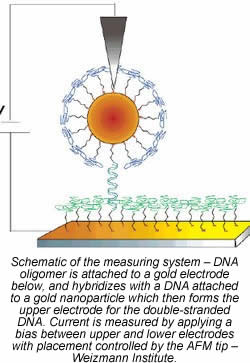 Because
DNA is able to recognize other molecules, other strands
of DNA, and because it binds together with similar
DNA strands in a very unique way, scientists have
suggested the possibility of using DNA as an electronic
circuit without having to build in any other circuitry.
The DNA would bind with other similar DNA strands
which it recognizes, then use the connecting properties
of the DNA to create a self-assembled biological wire
for electrical conduction. Until recently, uncertainty
existed about whether DNA could conduct at all, and
if it could, how well it could conduct. Scientific
speculations ranged from DNA being a superconductor
to a complete isolator. However, recent research by
Dr. Sidney R. Cohen in collaboration with Dr. Ron
Naaman and Dr. Claude Nogues of the Weizmann Institute
of Science, Scanned Probe Microscopy Unit, in Rehovot,
Israel, aided by the enabling technologies of ultra-high-resolution
microscopy and negative-stiffness vibration isolation,
has shed new light on the electrical transport properties
of DNA, focusing on the capacity of single molecules
of DNA to transport current along individual strands.
Because
DNA is able to recognize other molecules, other strands
of DNA, and because it binds together with similar
DNA strands in a very unique way, scientists have
suggested the possibility of using DNA as an electronic
circuit without having to build in any other circuitry.
The DNA would bind with other similar DNA strands
which it recognizes, then use the connecting properties
of the DNA to create a self-assembled biological wire
for electrical conduction. Until recently, uncertainty
existed about whether DNA could conduct at all, and
if it could, how well it could conduct. Scientific
speculations ranged from DNA being a superconductor
to a complete isolator. However, recent research by
Dr. Sidney R. Cohen in collaboration with Dr. Ron
Naaman and Dr. Claude Nogues of the Weizmann Institute
of Science, Scanned Probe Microscopy Unit, in Rehovot,
Israel, aided by the enabling technologies of ultra-high-resolution
microscopy and negative-stiffness vibration isolation,
has shed new light on the electrical transport properties
of DNA, focusing on the capacity of single molecules
of DNA to transport current along individual strands.
The Weizmann Institute’s Scanned Probe Microscopy
Unit
The Weizmann Institute’s Scanned Probe Microscopy
Unit provides research and imaging into nano-scale
electrical and mechanical properties of materials
and biological applications, such as with DNA. The
lab includes facilities for sample preparation and
testing involving ultra-high resolution microscopies
and localized surface probing using scanned probe
microscopies. The unit contains three separate scanning
tunneling/scanning force microscopes (Digital Instruments
Nanoscope, NT-MDT P47/LS and NTEGRA) that enable determination
of surface topography and mechanical and electrical
properties at resolutions ranging from tens of microns
down to atomic scale. Liquid cells, heated and cooled
stages, and a gas inlet allow working in different
media and under controlled temperature and humidity.
DNA
Measurement Challenges
Deoxyribonucleic acid (DNA) is a nucleic acid that contains
the genetic instructions used in the development and functioning
of all known living organisms and some viruses. The main role
of DNA molecules is the long-term storage of information.
DNA nanotechnology uses the unique molecular-recognition properties
of DNA to create self-assembling branched DNA complexes with
useful properties.
DNA molecules are very easily destroyed. Hooking up these
gold connectors and balls at the nano level without tearing
them off or burning them out is quite challenging. This preparation
method, developed by Dr. Nogues, is critical and somewhat
time consuming, but is a fundamental aspect of this research
model.
Vibration Isolation Critical to DNA Research
The Weizmann Institute is one of the few research groups in
the world that has actually managed to measure the electrical
transport properties of a single molecule of DNA. One of the
challenges that presents itself in nanoscale research is vibration
isolation. Every laboratory measuring and imaging at the nano-level
is dealing with problems of site vibration, which compromises
to a greater or lesser degree the imaging quality and data
sets which are acquired through ultra-high-resolution microscopy.
A critical factor in the Weizmann Institute’s ability
to consistently measure DNA electron structures at such extreme
nano-level resolutions is the lab’s use of negative-stiffness
vibration isolation systems, developed by Minus K Technology,
which produced the ultra-stable environment that the AFMs
needed to execute this research.
“Any lab site is subject to vibrations from machines,
vibrations of the building itself and even from people walking
around, in the range from less than 10 hertz to about 30 hertz,”
says Cohen. “The lab has three separate AFM systems,
each with several different modules that require very precise
vibration isolation for all of our research, including our
DNA electron transport studies. We have opted on negative-stiffness
vibration isolation to provide the necessary low-noise environment.”
Negative-stiffness mechanism (NSM) isolators have the flexibility
of custom tailoring resonant frequencies vertically and horizontally.
They employ a completely mechanical concept in low-frequency
vibration isolation. Vertical-motion isolation is provided
by a stiff spring that supports a weight load, combined with
a NSM. The net vertical stiffness is made very low without
affecting the static load-supporting capability of the spring.
“We tried air tables but they did not do very well for
us with the horizontal vibrations, continues Cohen. “Then
we compared active systems to the Negative-Stiffness isolator,
measuring the frequency spectrum up to about 100 hertz, and
the active systems did not perform as well as the negative-stiffness
isolator.”
Because they run on electricity, active systems can be negatively
influenced by problems of electronic dysfunction and power
modulations, which can interrupt scanning. They also have
a limited dynamic range – which is easy to exceed –
causing the isolator to go into positive feedback and generate
noise underneath the equipment. Although active isolation
systems have fundamentally no resonance, their transmissibility
does not roll off as fast as negative-stiffness isolators.
Leading the Way
The Weizmann Institute conducts original research into many
diverse areas, including mechanical properties of materials
and biological applications, such as with DNA. The method
for obtaining successful results from its research is a continuing
process of improving and refining its protocols, procedures,
equipment, and systems. Dr. Cohen, together with Doctor Nogues
and Doctor Naaman, continue to pioneer and lead the way to
a better understanding of the electron transport properties
of DNA molecules.
The full
article can be found at: https://minusk.com/content/in-the-news/MedDesTec_0610.htm

Featured Product: BM-8 Bench Top Is Now Stronger
Minus K Is proud to offer our largest
low height vibration isolator in four new capacities.
After mutilple requests to increase the payload range
of our popular BM-8, we have engineered the 125BM-8, 150BM-8
and 200BM-8.
One
special area of requests has been from the Audiophile
community. With high end turntables like the Simon Yorke,
TW Acustic Raven, VPI TNT and many others, the need for
the increased payload was evident.
The BM-8 bench top platform offers 10-100 times better
performance than a full size air table in a package only
4.6 inches tall, and without air or electricity!
This vibration isolation platform is extremely easy to use and offers extreme performance. It offers a 1.5 Hz horizontal natural frequency and our signature 0.5 Hz vertical natural frequency. There are only two adjustments.
This is the thinnest, most portable, and most user-friendly isolator ever offered that is capable of delivering this level of performance.
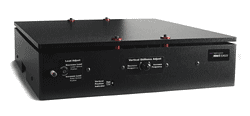
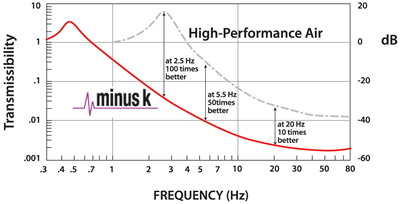
Minus K's BM-8 Bench Top Vibration Isolator
Typical transmissibility curve with 1/2 Hz natural Frequency
| Load Capacities (approximate): | ||
| Model | Payload Range* | Price** |
| 25BM-8 | 10 - 30 lb (4.5 - 14 kg) |
$2,640 |
| 50BM-8 | 25 - 55 lb (11 - 25 kg) |
$2,695 |
| 100BM-8 | 50 - 105 lb (23 - 48 kg) |
$2,750 |
| 125BM-8 | 90 - 130 lb (40 - 59kg) |
$2,805 |
| 150BM-8 | 125 - 155 lb (56 - 70 kg) | $2,860 |
| 200BM-8 [Weight: Approximately 47 lb. (21 kg)/same dimensions] | 140 - 210 lb (81 - 93kg) | $2,950 |
| *Contact Minus K for custom payload ranges. |
**For International Orders, A Handling Fee
of 5% is Added. |
|
Specifications:
Weight:
Approximately 40lb. (16 kg)
Dimensions:
18" W x 20" D x 4.6" H
(457mm W x 508mm D x 117mm H)
Performance
- Horizontal
frequencies are weight dependent.
- Horizontal
frequency of 1.5 Hz is achieved at the upper limit
of the payload range.
- At
the lower limits of the payload range the horizontal
frequency is approximately 2.5 Hz.
- Vertical frequency is tunable to 0.5 Hz throughout the payload range.
Negative-stiffness
isolators have resonant frequencies at 0.4 to 0.5 Hz, compared
to 2 to 3 Hz for typical pneumatic systems. They transmit
less energy from low-frequency vibrations to the payload
than do pneumatic systems, and maintain better isolation
performance through building frequencies to about 100 Hz
or more.
https://minusk.com/content/products/standard/bm-8_vibration_isolator_anti_vibration_isolators.html

The
Minus K BM-8 Isolation Platform
By Jeff Dorgay
Excerpted from Tone Audio-
June 2007
Aside from friends that have had too much to drink vibration is your turntable's biggest enemy. The more you can isolate your table from your environment the more musical detail your analog rig will be able to resolve.
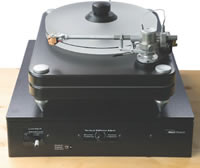 The
cool thing about the Minus K platform is that it is
a passive device, so that means no vacuum pump and none
of the extra noise that goes with a pump or the complexity
that it brings to the table. After all, the quieter
and more resolving your system gets, the last thing
you want is a pump in the background chugging away!!
The
cool thing about the Minus K platform is that it is
a passive device, so that means no vacuum pump and none
of the extra noise that goes with a pump or the complexity
that it brings to the table. After all, the quieter
and more resolving your system gets, the last thing
you want is a pump in the background chugging away!!
Unpack and Adjust
The BM-8 is 18" wide by 20" deep and 4.6"
high so make sure that you have enough room on your
shelf or rack, as well as the ability to support the
35 pounds of the platform in addition to your turntable.
There are multiple models, to accommodate equipment
from 10-200 pounds. I would suggest to get maximum performance,
if you can match the model you need so that your table
is in the middle to high end of the weight range.
Once you
have completed this part, nailing the sweet spot for the vertical
softness adjustment will take a bit more time, but is somewhat
of an adjust to taste setting. This affects the bounciness
of the springs in the platform and again after a lot of listening
noticed that by going from loose to tight will affect the
overall sound. As you might expect going a bit tighter consequently
tightens up the sound, and going a bit more springy gives
the overall presentation a bit warmer feel.
Even if you are
a bit off the mark, you should notice a good degree of improvement
and I felt that the more you listen and make fine adjustments,
you will notice a sweet spot where you are getting the maximum
isolation without the presentation getting too warm or bouncy.
Let's
start at the bottom and work our way up.
I noticed two major areas of improvement to the analog presentation
with the BM-8 in my system: Tighter, more tuneful bass and
better resolution of low-level detail. Just to make sure
I wasn't going mad, I picked out a wide range of albums
to listen to right in a row and then put the base in and
listened again. I used a lot of standards that perhaps are
not the audiophile standards, but records that I am infinitely
familiar with.
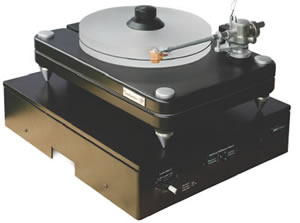 Though
this was great, the biggest improvement was the in
the area of low-level detail retrieval. I kind of
freaked out from the minute I started listening and
the more time I spent with the BM-8, the more I found
myself pulled into the music. Listening to all of
my Doors albums (the DCC versions) I really enjoyed
how much more air was in the presentation; there was
so much detail lurking in these already great LP's!
Again, this was not that subtle of an improvement.
I could really hear my system take a big jump in low
level resolution. This was one of those improvements
to your system that makes you go right to a lot of
your favorite records just to get a quick read on
the sound!
Though
this was great, the biggest improvement was the in
the area of low-level detail retrieval. I kind of
freaked out from the minute I started listening and
the more time I spent with the BM-8, the more I found
myself pulled into the music. Listening to all of
my Doors albums (the DCC versions) I really enjoyed
how much more air was in the presentation; there was
so much detail lurking in these already great LP's!
Again, this was not that subtle of an improvement.
I could really hear my system take a big jump in low
level resolution. This was one of those improvements
to your system that makes you go right to a lot of
your favorite records just to get a quick read on
the sound!
I highly recommend
the BM-8 with only one reservation; I would make this device
the icing on the cake of a very good system. If you have
everything else in your system the way you want it (including
room treatments) and are just aching for a little more performance,
I think you will be pleased with this upgrade. It's not
going to turn a budget table into a mega analog rig, but
it will allow you to see further in to the presentation
on a first rate system. I'm kind of thinking I need one...
•
The full
article can be found at: https://minusk.com/content/in-the-news/ToneAud_0607.html

Comments/Suggestions: Applications in New Fields or Features of Interest to You in Our Next Newsletter:
Upcoming Meetings and Webinars:
 |
|
||||||||||||||||||||||||||||||||||||

We want to hear from you:
Tell us if you have had a great experience with our isolators.
Work with us on an article about how negative-stiffness has helped
you. Don't be shy. Share your application with our readers.
Do you have an application in a New Field? What applications are
of Interest to You?
Email us at newsletter@minusk.com

460 S. Hindry Ave., Unit C Inglewood, CA 90301
Tel: 310-348-9656 Fax: 310-348-9638
Contact Us www.MinusK.com
© Minus K Technology Inc., Vibration Isolation
Systems. All rights reserved.